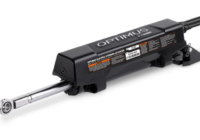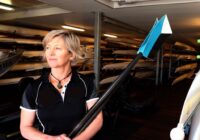Love your Lifejacket!
Did you know that approximately 70% of people who drowned in recreational boating incidents weren’t wearing a lifejacket.
Responding to community feedback, Transport for NSW Maritime has introduced a series of online mini-lessons to support individuals by providing valuable insights into the proper selection, wearing, and servicing of lifejackets.
From interactive scenarios and safety equipment checklists, to finding the perfect lifejacket for your furry friends, the mini-lessons are designed to be easily completed at your own pace, whenever and wherever you want.
Preparation: Maintaining your vessel and safety equipment before the boating season
Before heading out it’s important to do a thorough check to ensure both your vessel and safety equipment are in good working order, particularly if your vessel has been in storage over the winter months. Access a helpful Boating Safety Checklist here.

A well-maintained vessel will help ensure the safety of you and your crew and passengers when out on the water. Remember it’s the skipper’s responsibility to make sure the vessel and all safety equipment is in good working order. If anything needs fixing or replacing, do it before you head out.
Marine Rescue NSW have reported that the major causes of breakdown for powered vessels include mechanical failures, issues with motors, flat batteries and fuel shortage or contamination – all of which could have been avoided if the vessels involved had been regularly checked and maintained.
So, each time you plan to head out, take time to thoroughly check your battery, motor, fuel, water pump, lights and vessel structure. You must also ensure all safety equipment carried is in good condition, is in-date and that each item meets the appropriate specifications and standards. This includes checking that the lifejackets are maintained and serviced every 12 months, or in accordance with the manufacturer’s specifications, to ensure you and your crew and passengers can rely on them if you ever need to. A comprehensive list of how to check and maintain your vessel and safety equipment is available on the website.

Have you serviced your lifejacket?
The Maritime Boating Education Officers have been on the lookout for faulty safety equipment that has been lying dormant.
As a reminder, before launching your vessel and enjoying the water, please check you have enough lifejackets on board for all boaters and that the lifejackets are functional. Follow these basic steps to service a self-inflating lifejacket:
- Open the bladder ad check the canister is free form erosion and rust.
- Weigh the canister and check if it is fully gassed
- Inflate the lifejacket and leave it overnight to ensure it is free from holes.
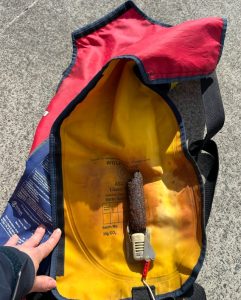
The Maritime NSW Boating Education Officers and on water Boating Safety Officers, work tirelessly to educate boaters on how to correctly service and maintain their lifejackets through every interaction, boating/ fishing club presentation and community event. So, if you see one of the friendly Maritime people, and you have any questions about your lifejacket, please ask them.
Exasperated with expired Marine Flares?
Don’t be! Maritime NSW’s Expired Flares Collection Program provides the boating community with an opportunity to safely dispose of their out of date flares. The locations and dates for collection are now available on our website.
Check the expiry date of your marine flares. Click on the link below for collection locations and available dates, then bring in any expired flares to your preferred collection point.
The next round of collection will take place in April. View collection locations and dates here.
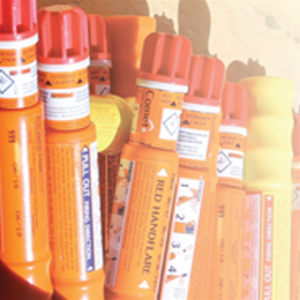
Do you get into knots trying to convert KMs to Knots?
Did you know that speeding is a key factor in incidents on NSW WWaterways? Many rivers and waterways have restricted knot speeds. Going faster than the speed limit and not wearing a lifejacket can result in penalties.
To help recreational boaters stick to the appropriate speeds Maritime NSW have developed knots conversion stickers that can be put on any jet ski or recreational vessel. To pick one up please visit your local NSW Service Centre!

Personal Watercraft (otherwise known as Jet Skis) Safety on NSW Waterways: Staying Safe on the Water
PWC usage is a popular and thrilling way to enjoy New South Wales’ beautiful waterways. From the sparkling shores of local waterways to the serene rivers and lakes of the hinterland, Jet skis offer an exciting experience for riders of all ages. However, with the increased popularity of Jet skis comes the responsibility of ensuring safety for all water users. NSW Maritime is committed to promoting safe and responsible practices on the water, particularly when it comes to the operation of PWCs.
In this article, we will explore the essential safety guidelines for operating PWCs on NSW waterways, ensuring that riders stay safe while enjoying the adventure that comes with these high-speed crafts.
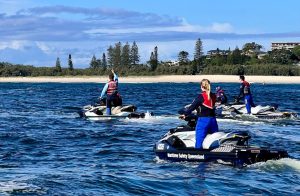
Understanding Safety Regulations
In NSW, safety regulations for PWCs are in place to protect both riders and other water users. Whether you’re a seasoned rider or new to the sport, it’s crucial to be familiar with the rules and to follow them diligently. Below are some of the most important safety regulations for PWC operators:
1. Wear a Life Jacket
Wearing an Australian Standard-approved life jacket is a legal requirement for anyone riding a Jet ski, regardless of experience. Life jackets are designed to keep you afloat in the event of an accident, and wearing one significantly improves your chances of survival if you fall into the water. All persons on board or being towed must wear an appropriate lifejacket. A level 50 is recommended. Ensure that the life jacket fits properly and is in good condition, as it is your primary means of safety.
2. Operator Age Requirements
To operate a PWC in NSW, riders must be at least 12 years old and hold a current PWC licence. This ensures that riders have the necessary knowledge to operate the PWC safely. A PWC licence holder under the age of 16 has restrictions placed on them. They must not drive at a speed faster than 20 knots at any time, must not travel faster than 10 knots unless there is another person on board over the age of 16 who holds a current PWC licence, and the operator must not travel at a speed faster than 10 knots whilst towing a person at any time.
3. PWC Licensing
To operate a PWC in NSW you must have a PWC licence. To get a PWC licence you must first have a boat licence, be aged 12 or over and pass the PWC knowledge test. You can obtain your PWC licence by studying and attempting the online test through Service NSW or you can complete the PWC course through an Authorised Training Provider. These courses cover important topics such as safe operating speeds, navigating in high-traffic areas, and understanding specific PWC handling.
You must have you PWC licence on you at all times whilst operating a PWC on NSW waterways, no exceptions.
4. Speed Limits and Zones
Speed limits vary across different waterways, and it is essential to adhere to local speed regulations to reduce the risk of accidents. Always be aware of posted speed limits, especially in busy areas. If you hold a PWC licence and are under the age of 16 ensure you are aware of the restrictions applying to you. Remember no one can operate a PWC between sunset and sunrise.
5. Navigational Rules
PWCs must adhere to the same navigational rules as other vessels as well as comply with irregular riding restrictions and exclusion zones.
Remember, when operating a PWC, you are responsible for avoiding collisions, so always be aware of your surroundings and travel at a safe speed at all times.
6. Safe Distance from Other Vessels
Maintaining a safe distance from other vessels, swimmers, and divers is essential for safety. When travelling at 6 knots or more, including when you are towing someone you must maintain a minimum distance of 60 meters from people in the water and dive flags and 30 meters from any other vessel or structure (including navigation marks). Always adjust your speed and direction to avoid risky situations.
7. Alcohol and Drug Use
As with all boating activities, consuming alcohol or drugs before or while operating a PWC is not recommended. Operating a PWC under the influence of alcohol or drugs increases the risk of accidents, and if you are found to be over the prescribed concentration of alcohol, you can face heavy fines including imprisonment.
Top Tips for Safe Operation of a PWC
In addition to following the rules and regulations, here are some practical safety tips to ensure a safe and enjoyable ride:
1. Pre-Ride Check
Before taking your PWC out on the water, always conduct a thorough pre-ride check. This includes checking fuel levels, the condition of the engine, and the functionality of safety equipment such as life jackets and ensure the kill switch is functioning correctly.
2. Use the Kill Switch
The kill switch is a vital safety feature that instantly shuts off the engine if you fall off or are thrown from the PWC. Always attach the kill switch lanyard to your wrist and test it before setting off.
3. Stay Alert
Stay aware of other vessels, submerged obstacles, and changes in weather conditions. Never operate a PWC at high speeds in unfamiliar waters. Keep a watchful eye on other water users and avoid distractions while riding.
4. Never Ride Alone
If possible, always ride with a buddy. Having someone with you can be a lifesaver in the event of an emergency. If you’re in trouble, they can call for help or assist you in returning to shore.
5. Take Regular Breaks
Riding a PWC can be physically demanding. Take regular breaks to rest and hydrate, especially on longer rides. Fatigue can impair your ability to react quickly, so it’s important to stay alert and focused.
Respecting Other Water Users
To keep yourself and fellow recreational boaters and locals safe on our waterways, always be considerate of noise levels and take care not to disturb wildlife or environmentally sensitive areas. Ensure you comply with restrictions regarding irregular riding. If you are within 200m from the shoreline where one or more dwellings are located within 200m of that shoreline then it is illegal to operate your PWC in an irregular manner.
This includes any weaving or diverting and driving in a circle or other pattern. This helps ensure everyone can enjoy the water safely and peacefully.
Whether you’re riding in a tranquil river or enjoying our busy waterways, following safety protocols and adhering to the rules of the waterways ensures that all PWC users stay safe and enjoy their time on the water.
NSW Maritime are committed to promoting safe and responsible boating practices for everyone.
By staying informed, prepared, and vigilant, PWC operators can minimise the risk of accidents and make the most of NSW’s spectacular waterways. For more information on PWC safety and boating regulations, visit the Transport for NSW Maritime website. Stay safe and enjoy your time on the water!





